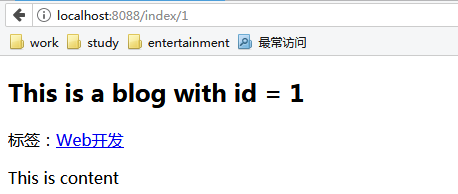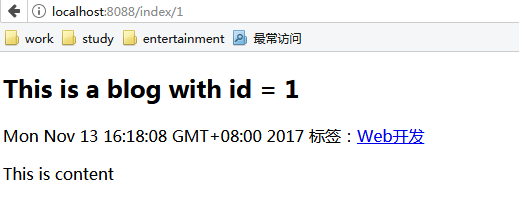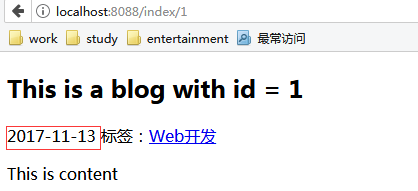模板
开发Web站点的本质,其实就是根据浏览器发起的请求(输入),生成HTML代码返回给浏览器(输出)。在之前的学习中,我们已经通过文件的形式存储起来而不是直接在Java代码中生成HTML代码。另一方面,博客站点是动态的,即不同的请求返回的内容可能不同。但是对于同一类请求,例如访问id分别为1和2的两篇文章,对应的URL分别为/blogs/1和/blogs/2,他们返回的HTML代码片段的结构几乎是一样的:
<!DOCTYPE html> <html xmlns="http://www.w3.org/1999/xhtml" xmlns:th="http://www.thymeleaf.org"> <div class="col-sm-8"> <div class="page-header"> <h2 th:text="${title}">Cum sociis(博客标题)</h2> <p class="blog-post-meta"><span th:text="${createdTime}">2015年2月3日</span> 标签:<a href="#">Web开发</a></p> </div> <div class="blog-post-content" th:text="${content}"> ... (这里是博客内容) </div> </div> </html>
th:text="${title}"就是告诉模板引擎,用title变量作为<h2>标签的内容(createdTime,content也是一样)。
注意为了显示博客创建时间,我们将时间放入了一个<span>标签中,用于和其他文字区分开。
Model
为了让模板引擎知道这些变量的值,我们需要再@Controller做一些工作:
@RequestMapping("/index/{id}")
public String getIndex(@PathVariable("id") int id ,Model model) {
// return "index";
//这里模拟一些数据
model.addAttribute("title","This is a blog with id = " + id);
model.addAttribute("CreatedTime","2017-11-13");
model.addAttribute("content","This is content");
return "index";
}
在上面的代码中,index()方法增加了一个Model类型的参数。通过Spring MVC框架提供的Model,可以调用其addAttribute方法,这样Thymeleaf可以访问Model中的变量从而进行模板渲染。上述例子中可以看到,title变量的值是根据URL中的@PathVariable来确定的,虽然简单,但是这已经是一个动态页面了。
在Servlet编程中,如果希望在页面中动态渲染信息,一般需要往HTTPRequest中添加属性,然后再JSP中获取。其实Model的属性实际上也是放在HttpRequest的属性中,但是Spring MVC提供了更高层的抽象,帮你屏蔽了HttpRequest,你看到的只有直接以MVC中M(即Model)
如果你依然希望使用HttpRequest,HttpResponse和HttpSession等原生的Servlet API对象,往Controller方法中增加对应类型的参数即可,你在方法中就能直接使用了,Spring MVC会传递给你正确的对象。
运行结果:

Model中添加对象
在上面的例子中,我们已经将单篇文章的页面动态化,但是这个动态化只是一个例子,当我们真正拥有数百篇博文时,并且还会添加(或者删除,更新)。显然不能够直接在@Controller方法中这样来填充Model,另外如果需要渲染文章列表,那么这种方法显然也是不行的。
为了解决这个问题,我们需要使用参考代码JAR包中提供的Blog类:
package Entity; import java.util.Date; public class Blog { private int id; private String title; private String content; private Date createdTime; public int getId() { return id; } public void setId(int id) { this.id = id; } public String getTitle() { return title; } public void setTitle(String title) { this.title = title; } public String getContent() { return content; } public void setContent(String content) { this.content = content; } public Date getCreatedTime() { return createdTime; } public void setCreatedTime(Date createdTime) { this.createdTime = createdTime; } }
在单篇文章页面里,对于每一个属性,都需要调用一次Model.addAttribute()方法,属性如果很多就会很不方便。现在我们有了Blog对象,可以将它放入Model:
@RequestMapping("/index/{id}")
public String getIndex(@PathVariable("id") int id ,Model model) {
// return "index";
//这里模拟一些数据
// model.addAttribute("title","This is a blog with id = " + id);
// model.addAttribute("CreatedTime","2017-11-13");
// model.addAttribute("content","This is content");
Blog blog = new Blog();
blog.setId(1);
blog.setTitle("This is a blog with id = " + id);
blog.setContent("This is content");
blog.setCreatedTime(new Date());
model.addAttribute("blog",blog);
return "index";
}
根据URL中的id获取对应的Blog对象,然后交给模板引擎渲染blog,相应的在模板中的变量表达式也要发生变化:
<!DOCTYPE html> <html xmlns="http://www.w3.org/1999/xhtml" xmlns:th="http://www.thymeleaf.org"> <div class="col-sm-8"> <div class="page-header"> <h2 th:text="${blog.title}">Cum sociis(博客标题)</h2> <p class="blog-post-meta"><span th:text="${blog.createdTime}">2015年2月3日</span> 标签:<a href="#">Web开发</a></p> </div> <div class="blog-post-content" th:text="${blog.content}"> ... (这里是博客内容) </div> </div> </html>
运行结果:

提高:往Model中添加对象有两种方式:
- model.addAttribute("blog",blog);
- model.addAttribute(blog);
使用第二种时,对象在Model中的命名默认为类名的首字母小写形式,任何时候对于同一种类型,只可能存在一个这样的“匿名”对象。
日期格式化
文章页面经过模板渲染处理后,还存在一个小问题:日期格式。现在对于${blog.createdTime}的渲染结果是Mon Nov 13 16:18:08 GMT+08:00 2017 ,这是因为${blog.createdTime}是一个Date对象,模板引擎在渲染的时候直接调用它的toString()方法。格式化日期是一个非常常见的任务,为此Thymeleaf提供了内置的支持:
<p class="blog-post-meta"><span th:text="${#dates.format(blog.createdTime,'yyy-MM-dd')}">2015年2月3日</span> 标签:<a href="#">Web开发</a></p>
#dates是Thymeleaf内置的一个工具类,format()方法可以指定日期的格式。
运行结果:
